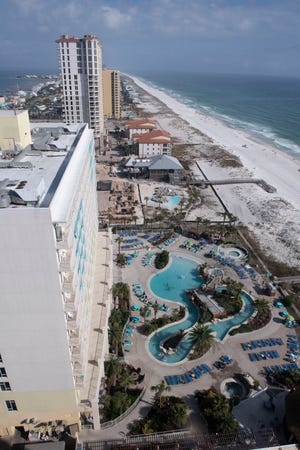Pensacola’s tourism industry had another record-setting year during 2022, and tourism marketing officials are looking for ways to hold on to those gains.
Visit Pensacola submitted its annual visitor tracking study to Escambia County last week that showed the tourism numbers for the 2022 fiscal year.
The tracking study reported more than 2.5 million visitors to Pensacola from October 2021 to September 2022 with visitors spending more than $1.3 billion and generating $21.8 million for Escambia County’s Tourism Development Tax.
Escambia County saw a 23.5% increase in the collection of Tourism Development Tax in 2022, however in 2021, the county passed the fifth cent to the TDT, which throws off a year-over-year comparison. To adjust for this, Visit Pensacola also provided the metric for the collection increase for just the first four cents of the TDT, which shows a 14.7% increase over 2021.
Tourism after pandemic:Post-pandemic Pensacola Beach is a bustling, budget-friendly vacation destination
Still, Visit Pensacola said in the report that the record increase in 2021 was “unsustainable,” and 2022 was a return to “more normal visitation levels” after the record boom in 2021.
Darien Schaefer, CEO of Visit Pensacola, told the News Journal that in 2021 Pensacola benefited from Florida being one of the few states open with no COVID-19 restrictions, but in 2022 restrictions were largely lifted everywhere.
“It’s just natural that that that demand gets dissipated over many, many, many more options, and that initial burst (of travel) tends to subside as well,” Schaefer said.
Schaefer said Visit Pensacola entered 2022 with the hope that if they could just keep the same level of visits as 2021 saw, it would be an accomplishment.
View in new tab
“What happened is, we were able to hold on to the 2021 numbers for the most part,” Schaefer said. “We saw the visitation even grow on top of ’21. The number of room nights, spending, economic impact, everything was up, not necessarily by huge double-digit percentage points like we had ’21.”
Every indicator Visit Pensacola measures increased positively in 2022 except for lodging occupancy, despite more visitors than in 2021.
Pensacola’s lodging occupancy was down by 7.7% from the previous year leaving Pensacola hotels with a 68% occupancy rate.
Schaefer said the decrease in that number is attributable to the increase in the number of hotel rooms available in Pensacola.
“We had more inventory,” Schaefer said. “We had more hotel rooms available, and we had more vacation rental listings.”
The increase in visitors was also seen in the number of cars going to Pensacola Beach over the Bob Sikes Toll Bridge.
Escambia County Commissioner Robert Bender told his fellow commissioners on Thursday the county recorded a 650,000-vehicle increase in the number of cars going through the toll booth bringing the total to 4.8 million cars.
“It was a good year for vehicles headed out the beach,” Bender said.
Schaefer said Visit Pensacola, whose job is to market and promote Pensacola as a destination, is concerned about the impact of any downturn in the economy but said people still put a high value on travel.
“Travel is still going to be something that folks are going to spend on even though we see prices really go high on other things. Maybe you don’t buy Ritz crackers anymore, you’re buying the generic knockoffs, but you’re still going to take the trip,” Schaefer said. “We’ll see people making adjustments on other things, but the longer this goes on, the cost of things increasing, or if you want to call it a recession, it affects everything. So that’s something that we’re certainly concerned about long term.”
Visit Pensacola also calculated the economic impact of tourism for 2022. The report said the total economic impact was $2 billion, with $1.3 billion coming from direct spending by tourists.
Tourism supported 22,149 jobs in the local economy and generated $638.7 million in salaries and wages.
The report said Escambia County taxpayers also saw a net benefit of $61.4 million to county revenue when comparing the cost of using county services and infrastructure versus the revenue they provide through taxes.
Going into 2023, Schaefer said Visit Pensacola is looking to market to people who will be interested in coming in the “off-season” months, such as remote workers or retirees.
“Our goal is to make sure that our tourism industry — year-round — is strong,” Schaefer said.











